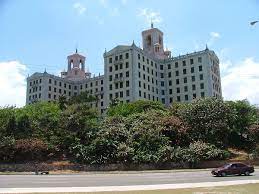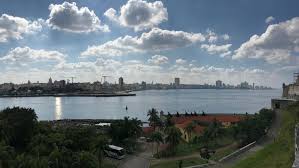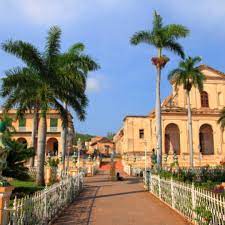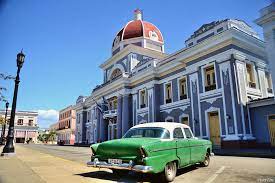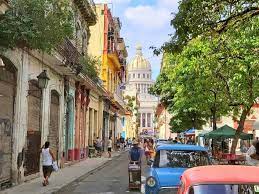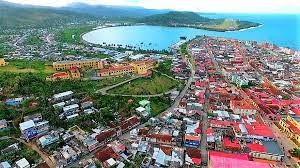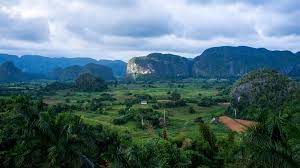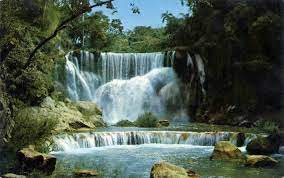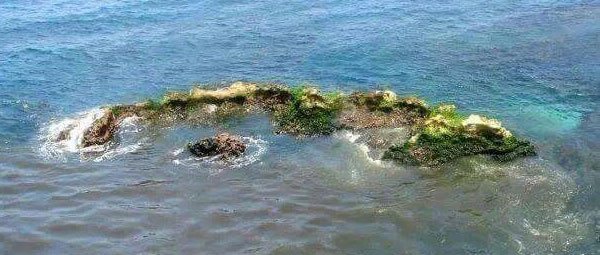EL HOTEL NACIONAL, LA HABANA, CUBA CUMPLE 91 AÑOS DE HISTORIA Y DE GRANDEZA. FOTOS
El Hotel Nacional de Cuba es un histórico hotel de estilo ecléctico español en La Habana, Cuba, inaugurado en 1930. Ubicado en el paseo marítimo del distrito de Vedado, se encuentra en el cerro Taganana, ofreciendo impresionantes vistas del mar y la ciudad.
El Hotel Nacional de Cuba ha celebrado los 91 años de su inauguración aún hoy con el brillo y la elegancia que desafía sus muchos años de inauguración. El hotel abrió como El Hotel Nacional de Cuba el 30 de diciembre de 1930, operado por los gerentes estadounidenses del Hotel Plaza, el Hotel Savoy-Plaza y el Hotel Copley Plaza, en un momento en que Cuba era un destino de viaje principal para las personas en los EE. UU.
En 1933, después del golpe de Fulgencio Batista el 4 de septiembre de 1933 contra el gobierno de transición, The National Hotel fue la residencia de Sumner Welles, un enviado especial enviado por el presidente estadounidense Franklin D. Roosevelt para mediar en la crisis. Poco después, del 2 al 3 de octubre de 1933, fue escenario de un sangriento asedio que se conocería como la Batalla del Hotel Nacional de Cuba. El conflicto enfrentó a los oficiales del ejército cubano, escondidos en el hotel, que habían sido fundamentales en el derrocamiento de Gerardo Machado pero se oponían a Batista, contra los suboficiales y otras filas del ejército cubano, que apoyaban a Batista. Su exitoso asalto al hotel dejó más de cuarenta combatientes muertos y causó grandes daños al edificio, incluidos impactos de bala y proyectiles.
El Hotel Nacional fue restaurado poco después y reabierto. En 1939, pasó a llamarse Hotel Nacional de Cuba. El desarrollador de Chicago Arnold Kirkeby adquirió la propiedad en julio de 1943 y la operó durante más de una década como parte de su cadena Kirkeby Hotels.
DISEÑO Y CONSTRUCCIÓN
El Hotel Nacional fue diseñado por la firma de arquitectura neoyorquina McKim, Mead y White, financiado por el National City Bank de Nueva York y construido en catorce meses por la firma de ingeniería estadounidense Purdy and Henderson. La estructura contiene una mezcla de estilos, incluidos el sevillano, el romano, el morisco y el art déco. El pórtico de entrada de estilo palladiano tiene dos capiteles de columna estilizados y quoins de piedra coralina.
Con sus 457 habitaciones, la mayoría de ellas frente al mar (de las 16 suites y una presidencial), el hotel es también el eje de las reuniones más importantes del país, del turismo u otras áreas.
La distribución del Hotel Nacional se basa en dos cruces griegas, dando a la mayoría de las habitaciones vista al mar. Los 6 pisos típicos tienen 74 habitaciones y 63,641 pies cuadrados de área de piso. El octavo piso (piso superior) tiene 66 habitaciones y un área de 50,325 pies cuadrados. La huella del edificio mide aproximadamente 523 ‘x 265’. La estructura del edificio es un marco de acero, mientras que los elementos decorativos, incluidos los detalles de la planta baja, las columnas, los revestimientos de las paredes y gran parte del pavimento, están cubiertos de piedra coralina.
El hotel está ubicado en el cerro de Taganana, el sitio de la batería de Santa Clara, que data de 1797. Parte de la batería se ha conservado en los jardines del hotel, incluidos dos grandes cañones costeros que datan de finales del siglo XIX.
LA FAMOSA CONFERENCIA DE LA HABANA
A partir del 20 de diciembre de 1946, el hotel acogió la Conferencia de La Habana, una infame cumbre de la mafia internacional dirigida por Lucky Luciano y Meyer Lansky y a la que asistieron Santo Trafficante Jr., Frank Costello, Albert Anastasia, Vito Genovese y muchos otros. Francis Ford Coppola dramatizó la conferencia en su película El padrino II.
Estuvieron presentes delegados en representación de la ciudad de Nueva York, Nueva Jersey, Buffalo, Chicago, Nueva Orleans y Florida, con la delegación más grande de jefes del área de Nueva York-Nueva Jersey. Varios jefes importantes del Sindicato Judío estaban en la conferencia para discutir el negocio conjunto del Sindicato Judío La Cosa Nostra. Según las reglas de la conferencia, los delegados judíos no podían votar sobre las reglas o políticas de la Cosa Nostra; sin embargo, a los jefes del crimen judío se les permitió participar en cualquier empresa comercial conjunta, como el Hotel Flamingo.
Luciano abrió la Conferencia de La Habana discutiendo un tema que afectaría mucho su autoridad dentro de la mafia estadounidense; la posición de “capo di tutti capi” o “jefe de todos los jefes”. El último jefe oficial de todos los jefes había sido Salvatore Maranzano, que fue asesinado en septiembre de 1931. A fines de 1931, Luciano había eliminado este puesto superior y reorganizó la mafia italiana en “La Cosa Nostra”, o “Esta cosa de Nuestro”. Se había formado una junta directiva comúnmente llamada “Comisión” para supervisar las actividades delictivas, controlar las reglas y establecer políticas. La Cosa Nostra se convirtió así en la principal organización criminal dentro del Sindicato Nacional del Crimen.
Ahora bien, Luciano fácilmente podría haberse declarado heredero de Maranzano en 1932; en cambio, Luciano decidió ejercer el control entre bastidores. Este arreglo había funcionado hasta el regreso de Vito Genovese de Italia. Oficialmente, Genovese ahora era solo un caporegime; sin embargo, había dejado en claro que tenía la intención de tomar el control de la familia criminal Luciano. Desde la deportación de Luciano en 1946, el aliado de Luciano, Frank Costello, había sido el jefe interino de la familia Luciano. Como resultado, las tensiones entre las facciones Costello y Genovese habían comenzado a crecer. Luciano no tenía intención de dejar el cargo de jefe de familia; tenía que hacer algo con Genovese. Luciano también se dio cuenta de que Genovese amenazaba su autoridad e influencia general dentro de la mafia estadounidense, probablemente con el apoyo de otros jefes del crimen. Por lo tanto, Luciano decidió resucitar el puesto de jefe de todos los jefes y reclamarlo para sí mismo. Esperaba que los otros jefes lo apoyaran, ya sea afirmando oficialmente el título o al menos reconociendo que todavía era el “Primero entre iguales”.
En la conferencia, Luciano presuntamente presentó la moción para retener su puesto como máximo jefe en La Cosa Nostra. Luego, el aliado de Luciano, Albert “El Sombrerero Loco” Anastasia secundó la moción. Anastasia votó con Luciano porque se sintió amenazado por los intentos de Genovese de meterse en sus raquetas frente al mar. Jaque mate por la alianza Luciano-Costello-Anastasia, Genovese se vio obligado a tragarse sus ambiciones y planes para el futuro. Para avergonzar aún más a Genovese, Luciano animó a Anastasia y Genovese a resolver sus diferencias y darse la mano frente a los otros jefes. Este gesto simbólico estaba destinado a evitar otra sangrienta guerra de pandillas como la Guerra de Castellammarese de 1930-1931. Con Luciano solidificando su posición personal y aplastando la ambición de Genovese, por ahora, Luciano sacó a relucir la discusión sobre las operaciones de narcóticos de la mafia en los Estados Unidos.
EL HOTEL NACIONAL EN SUS MEJORES TIEMPOS
En septiembre de 1955, Kirkeby Hotels Corp. vendió el Hotel Nacional a una compañía cubana recién formada, Corporación Intercontinental de Hoteles, S.A., con la división Intercontinental Hotel Corp. de Pan Am asumiendo la propiedad parcial y también la administración de la propiedad. Alphons Landa, un destacado abogado de Washington, representó a Pan Am y organizó que otros clientes y amigos adquirieran acciones en la propiedad del hotel al mismo tiempo. Dave Beck, presidente de los Teamsters, y Roy Fruehauf de Fruehauf Trailer Corporation fueron socios silenciosos durante al menos 2 años. Fruehauf vendería su participación en el hotel en mayo de 1957; otros inversores lo perderían todo cuando Castro llegara al poder. Lansky planeaba tomar el ala del hotel de 10 pisos y crear suites de lujo para los jugadores de alto riesgo. Batista apoyó la idea de Lansky a pesar de que hubo objeciones de expatriados estadounidenses como Ernest Hemingway. Bajo el impulso de Lansky, se reformó un ala del gran vestíbulo de entrada para incluir un bar, un restaurante, una sala de exposiciones y un lujoso casino. Fue operado por Lansky y su hermano Jake, con Wilbur Clark como líder.
La nueva ala del hotel, que consta del Casino Internacional de Wilbur Clark, el Starlight Terrace Bar contiguo y el club nocturno Casino Parisién (hogar de las famosas aguas danzantes), se inauguró en 1956 con la actuación de Eartha Kitt, quien se convirtió en el primer negro del hotel. invitado. El casino y los clubes fueron un éxito inmediato. Según un artículo inédito enviado a Cuban Information Archives alrededor de 1956-57, “El bar estaba atendido por camareros locales y el casino administrado por caballeros de Las Vegas”. En la primavera de 1957, el casino, subarrendado por el hotel por una renta sustancial a Lansky, estaba generando tanto dinero en efectivo como los casinos más grandes de Las Vegas. A finales de 1958, el casino fue vendido a Michael McLaney y Carroll Rosenbloom.
DESPUES DEL PERIODO REVOLUCIONARIO
Después de la Revolución Cubana en enero de 1959, los casinos de La Habana fueron cerrados brevemente, pero fueron reabiertos rápidamente después de que las protestas de los trabajadores de los casinos se quedaron sin trabajo. Fidel Castro nacionalizó el hotel el 20 de marzo de 1960 y finalmente cerró el casino en octubre de 1960, casi dos años después de su derrocamiento de Batista.
Durante la crisis de los misiles cubanos, se instalaron cañones antiaéreos en el sitio de la batería de Santa Clara y se construyó una extensa serie de túneles debajo de la propiedad, que ahora está abierta al público en visitas guiadas.
Después de años de abandono debido a la reducción del turismo después de la revolución, el hotel se utilizó principalmente para alojar a diplomáticos y funcionarios de gobiernos extranjeros visitantes. El colapso de la URSS en 1991 obligó al partido comunista cubano, ansioso por las reservas de divisas, a reabrir Cuba a los turistas.
Símbolo de los hostales cubanos, cinco estrellas, el Hotel Nacional es operado hoy por el grupo militar cubano Gran Caribe.
INVITADOS FAMOSOS
En 1956, el cantante Nat King Cole fue contratado para actuar en Cuba y quería quedarse en el Hotel Nacional de Cuba, pero no se le permitió porque el hotel estaba segregado. El hotel había rechazado anteriormente a celebridades negras como Joe Louis, Marian Anderson, Jackie Robinson y Josephine Baker. Cole cumplió con su contrato y el concierto en el Tropicana fue un gran éxito. Al año siguiente, regresó a Cuba para otro concierto, cantando muchas canciones en español. Ahora se le rinde homenaje en forma de estatua y máquina de discos en el Hotel Nacional.
Jean-Paul Sartre se hospedó en el hotel poco después de la Revolución de 1960, con su esposa, la filósofa Simone de Beauvoir. La pareja entrevistó al Che Guevara, y Sartre escribió ‘Sartre visita Cuba’, que se publicó en La Habana en 1961, narrando sus vivencias. Desde entonces, el hotel ha puesto su nombre a la habitación en la que se quedó.
En sus más de 91 años de existencia, el Hotel Nacional ha tenido muchos invitados importantes, incluidos artistas, actores, atletas y escritores como Winston Churchill, el duque y la duquesa de Windsor, Jimmy Carter, Frank Sinatra, Ava Gardner, Rita Hayworth, Mickey Mantle, Johnny Weissmuller, Buster Keaton, Jorge Negrete, Agustín Lara, Rocky Marciano, Tyrone Power, Rómulo Gallegos, Errol Flynn, John Wayne, Marlene Dietrich, Gary Cooper, Marlon Brando, Ernest Hemingway, Yuri Gagarin, el científico Alexander Fleming, Minnesota (Estados Unidos) el gobernador Jesse Ventura, e innumerables Jefes de Estado iberoamericanos y monarcas europeos.
El Fabuloso Hotel Nacional es una parte importante del Emblema Turístico Nacional y de la Historia de Cuba.
THE NATIONAL HOTEL, HAVANA, CUBA IS 91 YEARS OF HISTORY AND GREATNESS. PHOTOS
The Hotel Nacional de Cuba is a historic Spanish eclectic style hotel in Havana, Cuba, opened in 1930. Located on the seafront of Vedado district, it stands on Taganana Hill, offering commanding views of the sea and the city.
The National Hotel of Cuba has celebrated 91 years of its opening even today with the shine and elegance that challenges its many years of inauguration. The hotel opened as The National Hotel of Cuba on December 30, 1930, operated by the American managers of the Plaza Hotel, Savoy-Plaza Hotel, and Copley Plaza Hotel, at a time Cuba was a prime travel destination for people in the U.S.
In 1933, after Fulgencio Batista’s 4 September 1933 coup against the transitional government, The National Hotel was the residence of Sumner Welles, a special envoy sent by U. S. President Franklin D. Roosevelt to mediate the crisis. Soon after, on October 2–3, 1933, it was the site of a bloody siege that would become known as the Battle of the Hotel Nacional of Cuba. The conflict pitted officers of the Cuban army, holed up in the hotel, who had been instrumental in the overthrow of Gerardo Machado but opposed Batista, against the non-commissioned officers and other ranks of the Cuban army, who supported Batista. Their successful assault on the hotel left over forty combatants dead and caused extensive damage to the building, including shell and bullet holes.
The National Hotel was restored soon after and reopened. In 1939, it was renamed Hotel Nacional de Cuba. Chicago developer Arnold Kirkeby acquired the property in July 1943 and operated it for over a decade as part of his Kirkeby Hotels chain.
DESIGN AND CONSTRUCTION
The Hotel Nacional was designed by the New York architecture firm of McKim, Mead, and White, financed by the National City Bank of New York and constructed in fourteen months by the U.S. engineering firm of Purdy and Henderson. The structure contains a mix of styles, including Sevillian, Roman, Moorish, and Art Deco. The Palladian-style entrance portico has two stylized column capitals and quoins of coral stone.
With its 457 rooms, most of them facing the sea (of the 16 suites and one presidential), the hotel is also the axis of the most important meetings in the country, tourism, or other areas.
The layout of the Hotel Nacional is based on two Greek crosses, giving the majority of the rooms a view of the ocean. The 6 typical floors have 74 rooms and 63,641 sq. ft. of floor area. The eighth floor (top floor) has 66 rooms and an area of 50,325 sq. ft. The footprint of the building measures approximately 523′ x 265′. The structure of the building is a steel frame, while the decorative elements including ground floor details, columns, wall facings, and much of the paving, are covered in coral stone.
The hotel is located on the Hill of Taganana, the site of the Santa Clara Battery, which dates back to 1797. Part of the battery has been preserved in the hotel’s gardens, including two large coastal guns dating from the late 19th Century.
THE FAMOUS HAVANA CONFERENCE
Beginning on December 20, 1946, the hotel hosted the Havana Conference, an infamous mob summit run by Lucky Luciano and Meyer Lansky and attended by Santo Trafficante Jr., Frank Costello, Albert Anastasia, Vito Genovese, and many others. Francis Ford Coppola dramatized the conference in his film The Godfather Part II.
Delegates were present representing New York City, New Jersey, Buffalo, Chicago, New Orleans, and Florida, with the largest delegation of bosses from the New York-New Jersey area. Several major bosses from the Jewish Syndicate were at the conference to discuss the joint La Cosa Nostra-Jewish Syndicate business. According to conference rules, the Jewish delegates could not vote on Cosa Nostra rules or policies; however, the Jewish crime bosses were allowed input on any joint business ventures, such as the Flamingo Hotel.
Luciano opened the Havana Conference by discussing a topic that would greatly affect his authority within the American Mafia; the position of “capo di tutti capi” or “boss of all bosses”. The last official boss of all bosses had been Salvatore Maranzano, who was murdered in September 1931. By the end of 1931, Luciano had eliminated this top position and re-organized the Italian mafia into “La Cosa Nostra”, or “This Thing of Ours”. A board of directors commonly called the “Commission”, had been formed to oversee criminal activities, control rules, and set policies. La Cosa Nostra thus became the top criminal organization within the National Crime Syndicate.
Now Luciano could easily have declared himself as Maranzano’s heir in 1932; instead, Luciano decided to exercise control behind the scenes. This arrangement had worked until Vito Genovese’s return from Italy. Officially, Genovese was now just a caporegime; however, he had made it clear that he intended to take control of the Luciano crime family. Since Luciano’s deportation in 1946, Luciano’s ally Frank Costello had been the acting boss of the Luciano family. As a result, tensions between the Costello and Genovese factions had started to fester. Luciano had no intention of stepping down as family boss; he had to do something about Genovese. Luciano also realized that Genovese threatened his overall authority and influence within the American mafia, probably with support from other crime bosses. Therefore, Luciano decided to resurrect the boss of all bosses position and claim it for himself. He hoped the other bosses would support him, either by officially affirming the title or at least by acknowledging that he was still “First Amongst Equals”.
At the conference, Luciano allegedly presented the motion to retain his position as the top boss in La Cosa Nostra. Then Luciano ally, Albert “The Mad Hatter” Anastasia seconded the motion. Anastasia voted with Luciano because he felt threatened by Genovese’s attempts to muscle in on his waterfront rackets. Checkmated by the Luciano-Costello-Anastasia alliance, Genovese was forced to swallow his ambitions and plan for the future. To further embarrass Genovese, Luciano encouraged Anastasia and Genovese to settle their differences and shake hands in front of the other bosses. This symbolic gesture was meant to prevent another bloody gang war such as the Castellammarese War of 1930–1931. With Luciano solidifying his personal position and squashing Genovese’s ambition, for now, Luciano brought up the discussion of the mob’s narcotics operations in the United States.
1950s HEYDAY
In September 1955, Kirkeby Hotels Corp. sold the Hotel Nacional to a newly formed Cuban company, Corporacion Intercontinental de Hoteles, S.A., with Pan Am’s Intercontinental Hotel Corp. division assuming partial ownership and also the management of the property. Alphons Landa, a prominent Washington attorney, represented Pan Am and arranged for other clients and friends to acquire shares in the hotel’s ownership at the same time. Dave Beck, President of the Teamsters, and Roy Fruehauf of the Fruehauf Trailer Corporation were silent partners for at least 2 years. Fruehauf would sell his interest in the hotel in May 1957; other investors would lose everything when Castro came to power. Lansky planned to take the wing of the 10-story hotel and create luxury suites for high-stakes gamblers. Batista endorsed Lansky’s idea even though there were objections from American expatriates such as Ernest Hemingway. Under Lansky’s impetus, a wing of the grand entrance hall was refurbished to include a bar, a restaurant, a showroom, and a luxurious casino. It was operated by Lansky and his brother Jake, with Wilbur Clark as the frontman.
The new wing of the hotel, consisting of Wilbur Clark’s Casino Internacional, the adjoining Starlight Terrace Bar, and the Casino Parisién nightclub (home of the Famous Dancing Waters), opened in 1956 with a performance by Eartha Kitt, who became the hotel’s first black guest. The casino and clubs were an immediate success. According to an unpublished article sent to Cuban Information Archives around 1956–57, “The bar was tended by local bartenders, and the casino managed by gentlemen from Las Vegas.” By the spring of 1957 the casino, sublet by the hotel for a substantial rent to Lansky was bringing in as much cash as the biggest casinos in Las Vegas. In late 1958 the casino was sold to Michael McLaney and Carroll Rosenbloom.
POST-CUBAN REVOLUTION
Following the Cuban Revolution in January 1959, Havana’s casinos were briefly shut down but were quickly reopened after protests by casino workers left out of work. Fidel Castro nationalized the hotel on March 20, 1960, and finally closed the casino in October 1960, almost two years after his overthrow of Batista.
During the Cuban Missile Crisis, anti-aircraft guns were set up on the site of the Santa Clara Battery, and an extensive series of tunnels were built under the property, which is now open to the public on guided tours.
After years of neglect due to the reduction in tourism following the revolution, the hotel was mainly used to accommodate visiting diplomats and foreign government officials. The collapse of the USSR in 1991 forced the Cuban communist party, anxious for foreign exchange reserves, to reopen Cuba to tourists.
Symbol of Cuban hostels, five stars, the National Hotel is operated today by the Cuban military group Gran Caribe.
FAMOUS GUESTS
In 1956, singer Nat King Cole was contracted to perform in Cuba and wanted to stay at the Hotel Nacional de Cuba but was not allowed to because the hotel was segregated. The hotel had earlier turned away black celebrities including Joe Louis, Marian Anderson, Jackie Robinson, and Josephine Baker. Cole honored his contract, and the concert at the Tropicana was a huge success. The following year, he returned to Cuba for another concert, singing many songs in Spanish. There is now a tribute to him in the form of a statue and a jukebox in the Hotel Nacional.
Jean-Paul Sartre stayed at the hotel just after the Revolution in 1960, with his wife, the philosopher, Simone de Beauvoir. The couple interviewed Che Guevara, and Sartre wrote ‘Sartre visits Cuba’, which was published in Havana in 1961, narrating his experiences. The hotel has since named the room he stayed in after him.
In its 91+ years of existence, the Hotel Nacional has had many important guests, including artists, actors, athletes, and writers such as Winston Churchill, the Duke and Duchess of Windsor, Jimmy Carter, Frank Sinatra, Ava Gardner, Rita Hayworth, Mickey Mantle, Johnny Weissmuller, Buster Keaton, Jorge Negrete, Agustín Lara, Rocky Marciano, Tyrone Power, Rómulo Gallegos, Errol Flynn, John Wayne, Marlene Dietrich, Gary Cooper, Marlon Brando, Ernest Hemingway, Yuri Gagarin, scientist Alexander Fleming, Minnesota (United States) Governor Jesse Ventura, and innumerable Ibero-American Heads of State and European monarchs.
The Fabulous Hotel National is part of the History of Cuba-made Tourist Emblem.
Agencies/ Wiki/ NationalHotelHist./ Extractos/ Excerpts/ Internet Photos/ Arnoldo Varona/ www.TheCubanHistory.com
THE CUBAN HISTORY, HOLLYWOOD.






